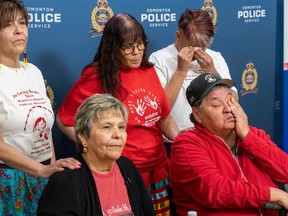
Article content
Andrew Quewezance gripped his cane, looked into a row of TV cameras and pleaded for someone to help end his family’s 15-year nightmare.
“I don’t want to leave this earth not knowing what happened to my daughter,” said the elder from Keeseekoose First Nation. “It’s a hard thing to go through when you don’t have any answers.”
Article content
“There’s a time for forgiveness, and in my life, I’m starting to forgive,” he added. “(But) I can’t forgive anybody I don’t know.”
Advertisement 2
Article content
Quewezance’s daughter, Michelle Lee Hadwen, died Oct. 8, 2009, two days after she was found injured on an Edmonton street. Detectives at the time exhausted their leads and transferred the file to the Edmonton police historical homicide unit, which recently reviewed the case.
Det. Kim Jay said she wants the public to know the investigation is still open and that tips could help solve it.
“While some information may seem insignificant, even a small detail, such as recalling Michelle enter a vehicle, a business, or transit, or talk to somebody — all of these things may help with the investigation.”
“If you remember seeing Michelle that night, please contact us as soon as possible.”

Hadwen, 37, came from James Smith Cree Nation and Keeseekoose First Nation in Saskatchewan. Her aunt, Vera Roy, remembered her as a “vibrant” and “beautiful” child.
“Tough little girl,” she recalled. “There was four or five relatives, boys, and they played a lot.”
Hadwen grew into an opinionated teenager with long brown hair and an exuberant streak.
“She was very outgoing, very outspoken, very rambunctious young lady,” Roy said. “Very small, petite. That was Michelle.”
Article content
Advertisement 3
Article content
Hadwen moved to Edmonton in 1991 and continued to travel back and forth between the city and her home province. In 2007, she moved to Edmonton permanently.
At the time of her death, Hadwen was living a “fairly transient” lifestyle centred on the 118 Avenue and 95 Street corridors, where she had “many” friends and acquaintances, Jay said. She frequented pubs in the area including the Mona Lisa, Reno’s, The Hub and The York Hotel.
Jay described Hadwen as part of Edmonton’s “vulnerable community” and said she sometimes relied on social agencies. Roy said as an adult, her niece was “in and out of institutions.”
“But I believe, as a mom, grandma, great grandmother, that we should all be treated … as one human being regardless of the lifestyle we live.”

Hadwen was last seen at The York, 10401 96 Street, a hotel and bar near EPS headquarters that has since been torn down. She left on foot around 9 p.m., headed west on 104 Avenue.
Her subsequent hours remain a mystery. A passerby discovered her body in the road at 79 Street and 121 Avenue around 4 a.m. the next morning. Hadwen’s cause of death is being withheld for investigative reasons, though police have ruled out her being struck by a car, Jay said.
Advertisement 4
Article content
Several of Hadwen’s loved ones attended Friday’s news conference wearing ribbon skirts and T-shirts drawing attention to missing and murdered Indigenous women. According to Statistics Canada, the rate of homicides against Indigenous women and girls between 2009 and 2021 was six times higher than the rate among non-Indigenous women.
Efforts to combat the problem in Edmonton include Project KARE, an RCMP task force created in 2003 after the remains of nine women were found in rural areas outside the city. The project included collecting DNA samples from more than 500 “high-risk” women and contributed to the conviction of Thomas Svekla, who was prosecuted for two murders and suspected of others.
Jay said detectives consulted with Project KARE at the time of Hadwen’s death, and that investigators remain in touch with RCMP.
She added DNA evidence has played a role in the case and investigators are looking into whether genetic genealogy — a technique used to solve other cold cases — might be helpful.
“It’s an ongoing exploration,” she said. “We’re always looking at the forensic exhibits with the lens of today’s technology.”
Advertisement 5
Article content
Roy said she will never stop fighting for her niece.
“I’ve always advocated for murdered and missing Indigenous women and I will continue to do that until my last breath,” she said. “I truly believe that someone knows something out there. So please, please, from the bottom of my heart, I ask you to come forward and help us.”
Anonymous tips can also be made to Crime Stoppers.
Recommended from Editorial
Article content





